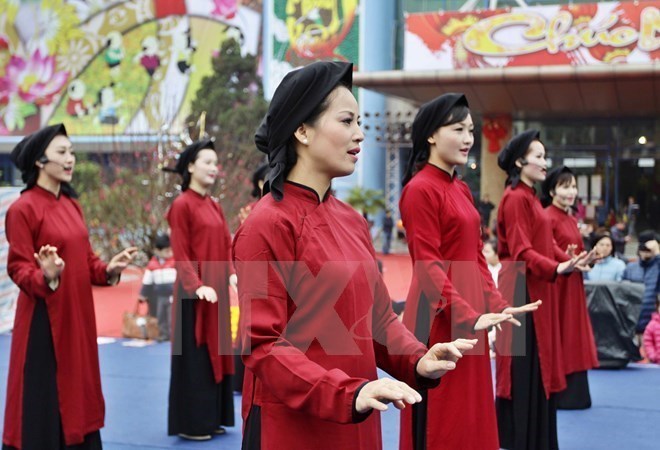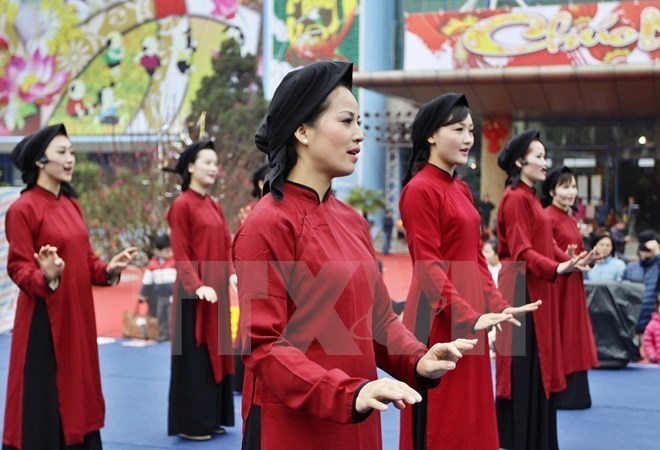
The northern province of Phu Tho launched a daily tour from Hanoi to the land of Hung Kings in early April, allowing tourists to explore traditional Xoan singing. The tour is designed to boost tourism and preserve the local intangible heritage, according to a local official.
Artists perform Xoan singing in Phu Tho province. (Photo: VNA).
The Hanoi – Phu Tho daily tour brings tourists to the Hung Temple relic site, Hung Kings Museum, Hung Lo ancient village and Lai Len Temple. Local artists perform Xoan (spring) singing between 2:00 pm and 4:00 pm at Hung Lo Communal House each day and at Lai Len Temple on weekends.
The new tour is not only vital for Phu Tho to attract more visitors but also helps the province preserve its cultural heritage, Xoan singing, which was put on UNESCO’s list of intangible cultural heritage of humanity in December last year, said Ha Ke San, Vice Chairman of the provincial People’s Committee.
Over the last six years, Phu Tho has worked to safeguard the folk music genre. It has established several Xoan singing clubs and taught it at schools across the province while training on Xoan singing performance has been also provided for promising singers, San noted.
"We hope senior artists and guild leaders will continue their training efforts to improve performing skills so visitors can get a better experience with the legacy,” said Director of the provincial Department of Culture, Sports and Tourism Nguyen Dac Thuy.
Xoan singing is practiced in Phu Tho province, often during the first two months of the lunar year. Traditionally, singers perform songs in sacred spaces such as temples, shrines and communal houses for spring festivals.
There are three forms of xoan singing: worship singing for the Hung kings and village guardian spirits, ritual singing for good crops, health and luck and festival singing where villagers alternate between male and female voices in a form of courtship.
Each Xoan music guild is headed by a leader, referred to as the "trum”, male instrumentalists are called "kep” and female singers "dao”.
Xoan singing is accompanied by dancing and musical instruments such as clappers and drums. The music has a sparse structure with few ornamental notes and simple rhythms, and Xoan is characterised by a modulation between singers and instrumentalists at the fourth interval. Knowledge for singing, dancing and playing drum and clappers are traditionally transmitted orally by the guild leader.
On the occasion of the Hung Kings Temple Festival, which is scheduled to take place between April 20 and 25 this year, Xoan singing performances will be held between 8:00 am and 4:00 pm every day at these two venues.
Legend has it that the Hung Kings ruled Vietnam from 2879 BC until 258 BC and are considered the founder of the nation. To honour the Kings, the tenth day of the Lunar March, which falls on April 25 this year, serves as the national commemorative anniversary for them.
Source: VNA
Spanning thousands of hectares and winding gracefully along mountain slopes, hillsides, and riverbanks, the terraced rice fields of Lac Son District present a stunning and captivating beauty. This region, renowned for its remarkable terraced landscapes, is also the centre of Hoa Binh Culture known for numerous archaeological sites.
The life of Mong people in Hang Kia and Pa Co communes of Mai Chau district has improved much thanks to tourism development.
The man-made Hoa Binh Lake, with a water surface area of approximately 9,000 hectares and a capacity of 9.45 billion cubic meters, stretches over 200 kilometers from Hoa Binh to Son La provinces. With the goal of developing into a national tourism area, the Hoa Binh Lake tourism area is expected to not only become the largest tourism centre in the province but also one of the 12 key tourist destinations in the northern midland and mountainous region of Vietnam.
Da Bia hamlet, now Duc Phong, in Tien Phong commune, Da Bac district, was once almost isolated from the outside as the only way to the hamlet was to get a boat ride across the Hoa Binh reservoir. However, as its tourism potential has been unleashed, the hamlet has established itself as one of the most attractive destinations on the tourism map. It has even received the ASEAN Community-Based Tourism Awards in 2019.
In the first 9 months of 2024, Mai Chau district, Hoa Binh province welcomed over 684 thousand visitors to visit and relax. In which, over 516 thousand domestic visitors and more than 168 thousand international visitors. Total revenue from tourism is estimated at over 821 billion VND.
Da Bac district, bestowed with stunning landscapes, is developing ecological and resort tourism offerings. Several tourist sites, put into operation this year, has attracted throngs of high-spending and young domestic visitors.



